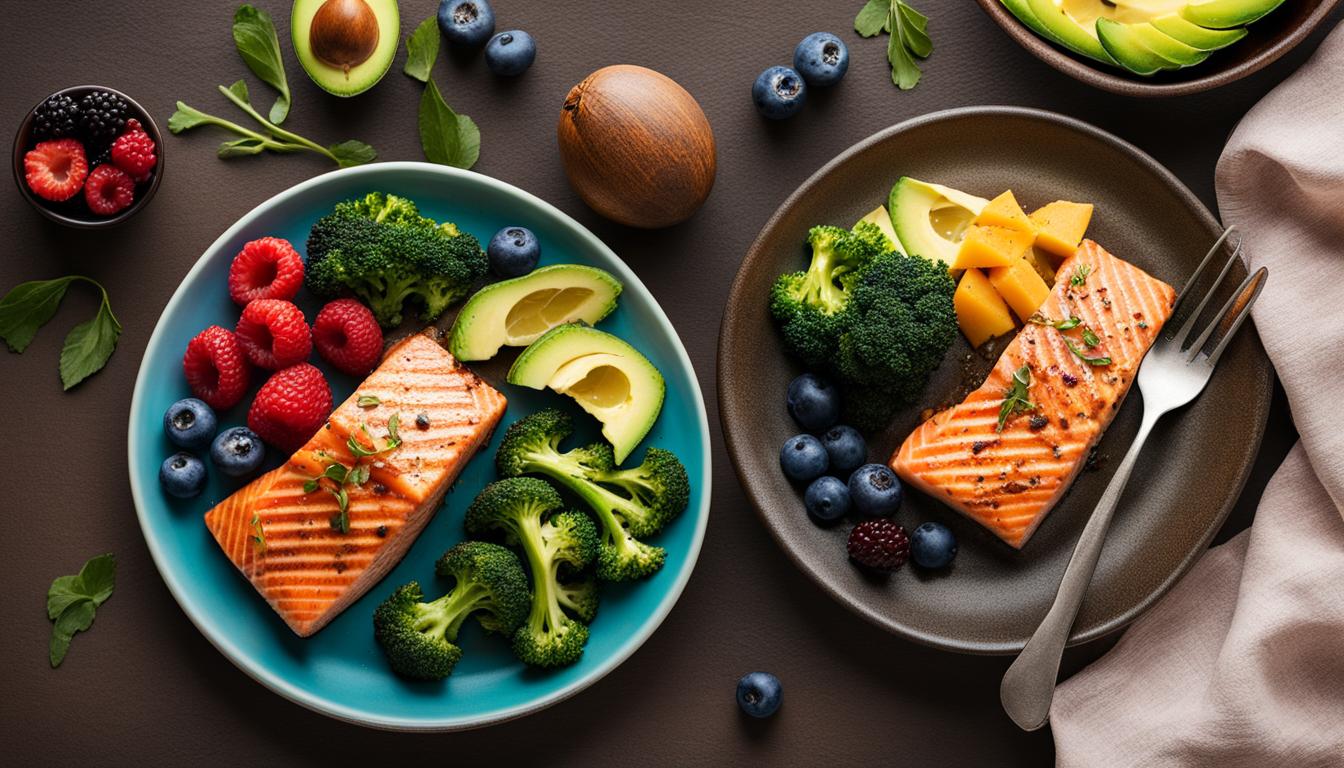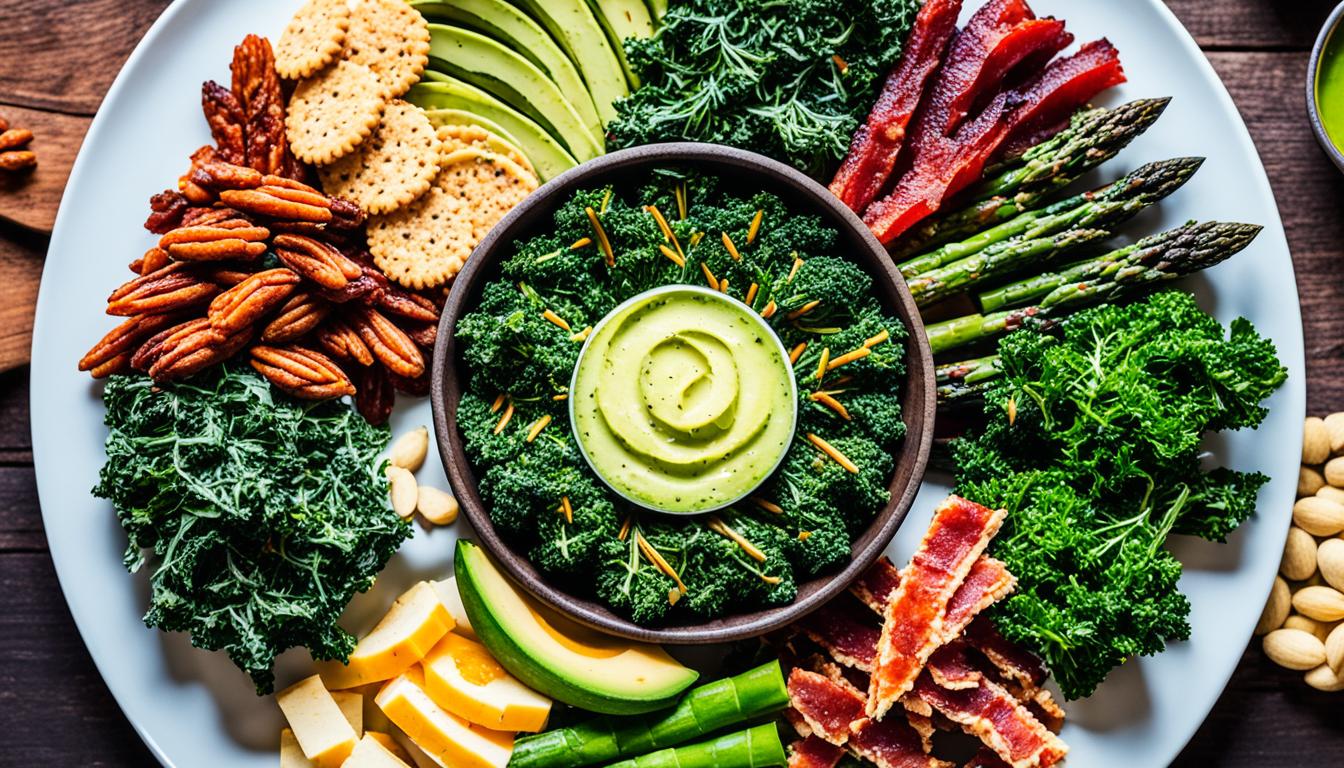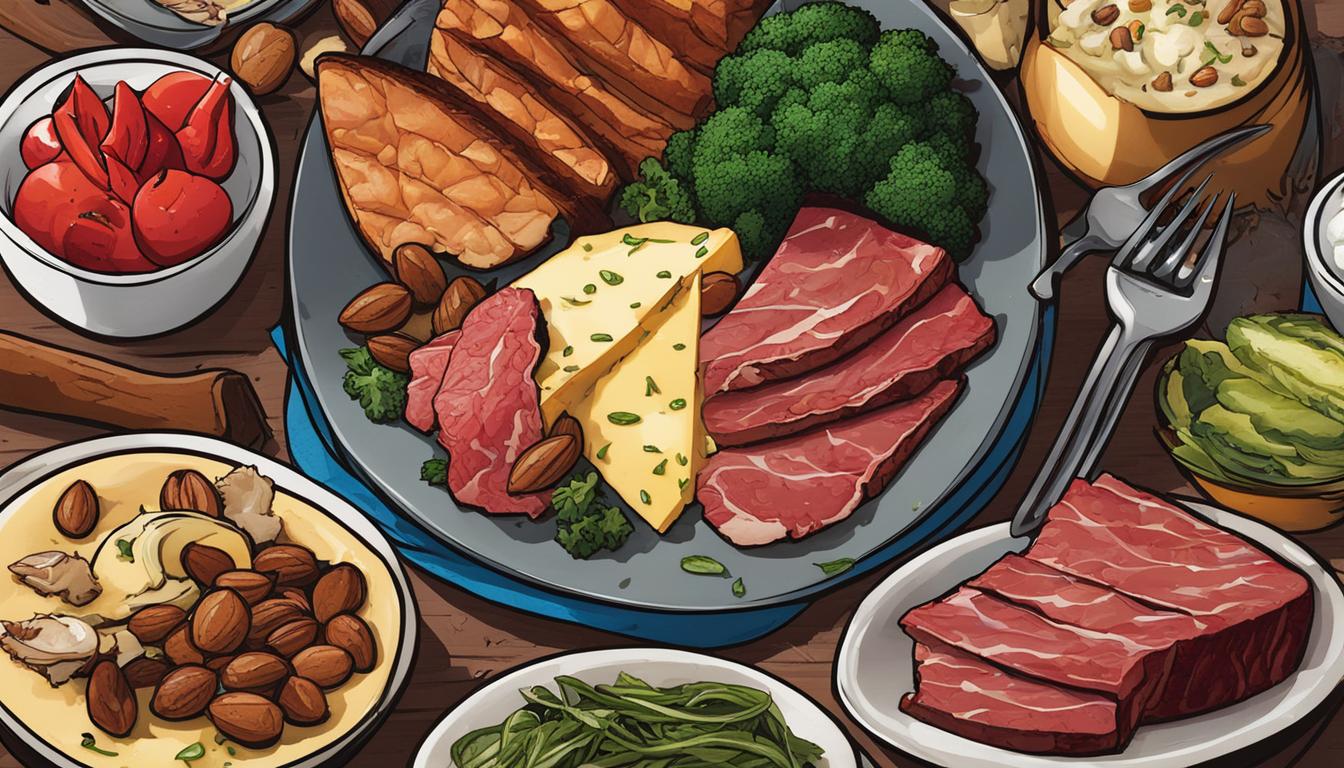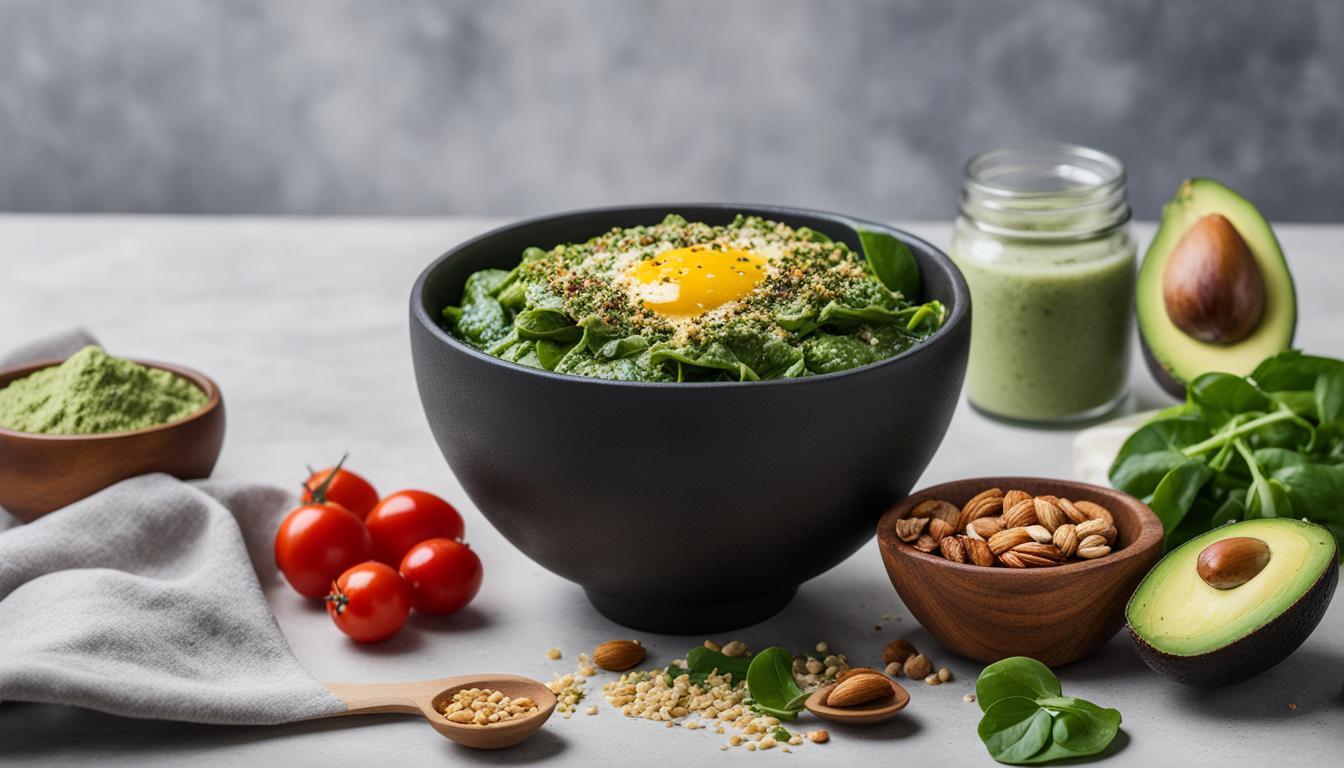Are you looking for the best keto meal plan to kickstart your weight loss journey? Look no further! The ultimate keto meal plan is here to help you achieve your health and wellness goals. With its focus on a high-fat, low-carb diet, the keto meal plan can put your body in a state of ketosis, where it uses fats as its primary source of energy instead of carbohydrates. Not only can this lead to weight loss, but it also offers a range of other health benefits.
Discover what to eat and what to avoid on the ultimate keto meal plan to maximize your results and improve your overall well-being. From delicious keto-friendly recipes to the basics of the ketogenic diet, we’ve got you covered. Say goodbye to cravings and hello to a healthier, happier you!
Key Takeaways:
- The ultimate keto meal plan is a high-fat, low-carb diet that promotes weight loss.
- By reducing carbohydrate intake, the body enters a state of ketosis, using fat for energy.
- Following the keto meal plan can lead to improved overall health and well-being.
- Discover keto-friendly foods to include in your meals and avoid high-carb options.
- Consult with a healthcare professional before starting any new diet or meal plan.
What is a Ketogenic Diet?
A ketogenic diet, also known as a high fat diet or low carb diet, focuses on reducing carbohydrate intake to induce a state of ketosis. Ketosis is a metabolic process where the body uses fat as its primary source of energy instead of glucose. This can lead to weight loss and improved overall health.
In a ketogenic diet, the macronutrient ratio is typically around 70-75% fat, 20-25% protein, and 5-10% carbohydrates. By drastically reducing carb consumption, the body switches its fuel source and begins breaking down stored fat into ketones, molecules that provide energy for the body in the absence of glucose.
“Switching to a ketogenic diet forces the body to adapt and become efficient at burning fat for fuel, which can result in weight loss and other health benefits.”
By following a ketogenic diet, individuals can enter into a state of ketosis and experience benefits such as improved weight management, increased energy levels, enhanced mental clarity, and stabilized blood sugar levels. The low carb nature of the diet can also help control appetite and reduce cravings for sugary and processed foods.
It is important to note, however, that a ketogenic diet may not be suitable for everyone. It is recommended to consult with a healthcare professional before starting any new dietary regimen, particularly if you have any underlying health conditions or take medications.
Basics of the Keto Diet
The keto diet, short for ketogenic diet, is a low carbohydrate, high fat, and moderate protein eating plan. It restricts carbohydrates to 20-50 grams per day on a 2,000-calorie diet. This diet is designed to shift the body’s primary energy source from glucose to ketones.
Ketones are produced in the liver from fats, and they serve as an alternative fuel for the body and brain when carbohydrate intake is limited. By reducing carbohydrate intake, the body enters a state of ketosis, where it becomes efficient at burning fat for energy.
One of the key aspects of the keto diet is its macronutrient ratio. It typically consists of 70-75% fat, 20-25% protein, and 5-10% carbohydrates. This macronutrient distribution ensures that the body remains in a state of ketosis and relies on fat as its primary fuel source.
Following a keto diet can have several benefits, particularly for weight loss. When the body is in ketosis, it becomes more efficient at burning stored fat for fuel, leading to a reduction in body weight and body fat percentage.
Additionally, the keto diet can help curb hunger and increase feelings of satiety due to its high-fat content. Fat takes longer to digest than carbohydrates, which can help prevent overeating and snacking between meals.
The keto diet is an effective way to lose weight and improve overall health. By reducing carbs and increasing fat intake, the body enters a state of ketosis and uses stored fat for energy.
Ketogenic Diet Meal Plan
Following a keto diet involves reducing carb intake while increasing fat and protein content. By focusing on keto-friendly foods, you can maximize the benefits of this diet. These foods are low in carbohydrates and high in healthy fats, making them ideal for carb reduction and achieving ketosis.
Here are some key keto-friendly foods to include in your meal plan:
1. Eggs: A versatile and protein-rich option that can be enjoyed in various forms.
2. Poultry: Chicken and turkey are excellent sources of protein and healthy fats.
3. Fatty Fish: Salmon, trout, and sardines are rich in omega-3 fatty acids.
4. Meat: Opt for cuts like beef, pork, and lamb, which are high in protein and healthy fats.
5. Full-Fat Dairy: Include options like cheese, butter, and heavy cream, which are low in carbs and provide essential nutrients.
6. Nuts and Seeds: Almonds, walnuts, chia seeds, and flaxseeds are packed with healthy fats and fiber.
7. Oils Rich in Healthy Fats: Choose oils like olive oil, coconut oil, and avocado oil to add healthy fats to your diet.
8. Avocados: A highly nutritious fruit rich in healthy fats and fiber.
9. Non-Starchy Vegetables: Broccoli, spinach, cauliflower, and kale are great options as they are low in carbs and high in fiber.
10. Condiments: Flavor your meals with keto-friendly condiments like salt, pepper, herbs, and spices.
On the other hand, there are certain foods that you should limit or avoid on a keto diet, as they are high in carbs. These include:
1. Bread: All types of bread, including whole wheat and gluten-free options.
2. Sweets: This includes sugar, candy, and desserts.
3. Sugary Beverages: Soft drinks, fruit juices, and sweetened teas should be avoided.
4. Pasta and Grains: Rice, noodles, and other grain-based products.
5. Starchy Vegetables: Potatoes, corn, and peas are high in carbs.
6. Beans: Legumes like lentils, chickpeas, and black beans are not keto-friendly.
7. High Carb Sauces: Barbecue sauce, ketchup, and most commercial salad dressings are high in carbs.
When following a keto diet, it’s important to focus on whole foods and avoid processed foods and trans fats. This will not only support your ketosis goals but also provide optimal nutrition for your overall health.

| Keto-Friendly Foods | Foods to Limit or Avoid |
|---|---|
| Eggs | Bread |
| Poultry | Sweets |
| Fatty Fish | Sugary Beverages |
| Meat | Pasta and Grains |
| Full-Fat Dairy | Starchy Vegetables |
| Nuts and Seeds | Beans |
| Oils Rich in Healthy Fats | High Carb Sauces |
| Avocados | |
| Non-Starchy Vegetables | |
| Condiments |
Keto-Friendly Beverages
When following a keto diet, it’s important to choose beverages that are low in carbs and sugar-free. Here are some keto-friendly options:
- Water: The ultimate hydrating drink, water has zero carbs and is essential for staying hydrated.
- Sparkling Water: If you’re looking for some fizz, opt for sparkling water without any added sugars or sweeteners.
- Unsweetened Coffee: Coffee can be enjoyed on a keto diet, just make sure to skip the sugar and any sweeteners. Add a splash of heavy cream or a sprinkle of cinnamon for flavor.
- Unsweetened Green Tea: Green tea is a great option for its antioxidants and potential metabolism-boosting properties. Drink it plain or add a squeeze of lemon.
- Low Carb Alcoholic Drinks (in moderation): If you choose to consume alcohol while on keto, opt for low carb options like vodka, gin, or tequila mixed with soda water and a slice of lime.
By choosing these keto-friendly beverages, you can stay hydrated and avoid the high carb and sugary drinks that can derail your progress. To make water more enjoyable, try infusing it with herbs or citrus slices for a burst of flavor.
Sample Keto Menu for 1 Week
Planning your meals ahead of time is key to successfully following a keto diet. Here’s a sample keto menu for one week to give you some meal ideas and inspiration. Remember, these meals are keto-friendly and low in carbs, making them perfect for your weight loss journey.
Day 1
- Breakfast: Eggs with sautéed greens
- Lunch: Burger with cheese and avocado
- Dinner: Pork chops with green beans
Day 2
- Breakfast: Mushroom omelet
- Lunch: Tuna salad
- Dinner: Roast chicken with cream sauce
Day 3
- Breakfast: Bell pepper stuffed with cheese and eggs
- Lunch: Arugula salad with hard-boiled eggs and turkey
- Dinner: Grilled salmon with spinach
Day 4
- Breakfast: Steak bowl with cauliflower rice
- Lunch: Bison steak with cheesy broccoli
- Dinner: Baked avocado egg boats
Day 5
- Breakfast: Caesar salad with chicken
- Lunch: Coconut chicken curry
- Dinner: Choose your favorite keto-friendly meal!
Day 6
- Breakfast: Eggs with sautéed greens
- Lunch: Burger with cheese and avocado
- Dinner: Pork chops with green beans
Day 7
- Breakfast: Mushroom omelet
- Lunch: Tuna salad
- Dinner: Roast chicken with cream sauce
Feel free to mix and match these meal ideas to create your own keto menu for the week. Remember to include plenty of vegetables and healthy fats in your meals. Bon appétit!
Keto Snack Options
When following a keto diet, finding appropriate snacks that are low in carbs can be challenging. However, with a bit of creativity, there are plenty of delicious and healthy options available. Here are some keto snack ideas to help you stay on track:
- Almonds and cheddar cheese: A perfect combination of healthy fats and protein.
- Avocado stuffed with chicken salad: A satisfying and creamy snack that is packed with flavor.
- Guacamole with low carb veggies: A tasty and nutritious dip that pairs well with celery, cucumber, or bell peppers.
- Trail mix with unsweetened coconut and nuts: A crunchy and portable snack that provides a good dose of fat and fiber.
- Hard-boiled eggs: A quick and easy snack that is high in protein and low in carbs.
- Kale chips: A crispy and flavorful alternative to potato chips.
- Olives and salami: A savory combination that is rich in healthy fats.
- Celery and peppers with cream cheese dip: A refreshing and low carb option that is perfect for dipping.
- Berries with heavy whipping cream: A sweet treat that is low in carbs and high in antioxidants.
- Jerky: A protein-packed snack that is portable and convenient.
- Cheese roll-ups: A simple and satisfying snack that can be made with your favorite cheese and deli meat.
- Parmesan crisps: A crunchy and cheesy snack that is perfect for satisfying cravings.
- Macadamia nuts: A rich and buttery nut that is low in carbs and high in healthy fats.
- Greens with high fat dressing and avocado: A refreshing and nutritious snack that provides a good amount of fiber.
- Keto smoothie: A creamy and satisfying option made with unsweetened almond milk, avocado, and your choice of low carb fruits.
- Avocado cocoa mousse: A decadent and creamy dessert that is low in carbs and high in healthy fats.
These keto snack options are not only delicious but also help to keep you satiated between meals. Remember to read labels carefully and choose snacks that are low in carbs and high in healthy fats. Incorporate these snacks into your keto meal plan to ensure you stay on track and achieve your health goals.

Simple Ketogenic Shopping List
A well-rounded ketogenic shopping list is essential for following a successful keto diet. When shopping for keto-friendly foods, prioritize fresh produce, healthy fats, and quality proteins. By focusing on whole, unprocessed foods, you can ensure that your meals are nutritious and satisfying. Here’s a simple shopping list to help you stock your pantry and fridge with keto-approved ingredients:
- Avocados
- Nuts and seeds
- Olive oil
- Coconut oil
- Butter
- Fatty fish (such as salmon or mackerel)
- Meats (including beef, poultry, and pork)
- Eggs
- Non-starchy vegetables (like spinach, kale, broccoli, and cauliflower)
- Healthy snacks (such as pork rinds, cheese, or keto-friendly protein bars)
When it comes to choosing produce, both fresh and frozen options can be included in your shopping list. Fresh produce is great for salads and side dishes, while frozen produce can be convenient for smoothies or cooking. Just make sure to avoid high-carbohydrate foods, starchy vegetables, and processed snacks that are not keto-friendly.
By having these items on hand, you’ll be well-prepared to create delicious, satisfying meals that align with your keto diet goals.
Benefits of the Ultimate Keto Meal Plan
The ultimate keto meal plan offers several benefits that can contribute to weight loss, improved health, and overall well-being. By following this high fat, low carb diet, individuals can experience positive changes in their body composition and overall health.
Here are some key benefits of the keto diet:
- Weight Loss: The primary benefit of the ultimate keto meal plan is its effectiveness in promoting weight loss. By restricting carbohydrate intake and increasing fat consumption, the body is forced to burn stored fat for energy, leading to a reduction in body weight. Research has shown that the keto diet can be more effective for weight loss compared to low-fat diets[*].
- Improved Blood Sugar Control: Following a keto diet can also help improve blood sugar control. By minimizing carbohydrate intake, the body experiences lower spikes in blood sugar levels, which is beneficial for individuals with diabetes or those struggling with blood sugar regulation[*].
- Appetite Control: The high fat and protein content of the keto diet can help promote satiety and reduce cravings. This can result in better appetite control, making it easier to stick to the meal plan and avoid unnecessary snacking or overeating[*].
- Potential Cognitive Benefits: Some studies suggest that the keto diet may have cognitive benefits. Ketones, which are produced during ketosis, can serve as an alternative fuel source for the brain, potentially improving focus, mental clarity, and cognitive function[*].
- Potential Epilepsy Treatment: The ketogenic diet was originally developed as a therapeutic diet for epilepsy treatment. It has been shown to reduce the frequency of seizures in both children and adults with epilepsy[*].
By emphasizing whole foods and minimizing processed foods, the ultimate keto meal plan can also contribute to improved overall health. It reduces the intake of refined sugars, unhealthy fats, and processed carbohydrates, which are often associated with an increased risk of chronic conditions such as obesity, heart disease, and type 2 diabetes.
For optimal results, it is important to customize the ultimate keto meal plan according to individual needs, preferences, and health goals. Additionally, regular physical activity and exercise should be incorporated into the lifestyle to enhance the benefits of the keto diet.
Benefits of the Ultimate Keto Meal Plan
| Benefits | Description |
|---|---|
| Weight Loss | Promotes fat burning and aids in weight loss[*]. |
| Improved Blood Sugar Control | Helps regulate blood sugar levels and can benefit individuals with diabetes[*]. |
| Appetite Control | Promotes satiety and reduces cravings[*]. |
| Potential Cognitive Benefits | Ketones produced during ketosis may enhance brain function[*]. |
| Potential Epilepsy Treatment | Reduces seizure frequency in individuals with epilepsy[*]. |
Overall, the ultimate keto meal plan provides a range of benefits that can lead to weight loss, improved health, and enhanced well-being. It is important to consult with a healthcare professional or registered dietitian before starting any new diet or meal plan to ensure it aligns with individual health needs and goals.
Conclusion
In summary, the ultimate keto meal plan is a comprehensive guide to following a ketogenic diet for weight loss and improved health. By reducing carbohydrate intake, increasing fat and protein intake, and focusing on whole, unprocessed foods, individuals can achieve their desired goals. This plan offers flexibility and customization options to suit individual preferences and dietary needs, ensuring a sustainable and enjoyable journey.
It is crucial to consult with a healthcare professional or registered dietitian before embarking on any new diet or meal plan. Their expertise can provide valuable guidance and address any concerns or specific requirements. By partnering with a professional, individuals can optimize their results and minimize any potential risks.
Embracing the ultimate keto meal plan can lead to numerous benefits, including improved health, increased energy, and successful weight loss. With careful planning and commitment, individuals can achieve their desired outcomes and experience the transformative power of the ketogenic diet. Remember, consistency and perseverance are key on this journey to a healthier lifestyle.
FAQ
What is a ketogenic diet?
A ketogenic diet is a high fat, low carb diet that focuses on reducing carbohydrate intake to induce a state of ketosis, where the body uses fat as its primary source of energy.
What are the basics of the keto diet?
The keto diet involves consuming 70-75% fat, 20-25% protein, and 5-10% carbohydrates. It restricts carbs to 20-50 grams per day and relies on ketones produced in the liver from fats for energy.
How does the keto diet help with weight loss?
The keto diet can help with weight loss by reducing hunger and increasing feelings of satiety. It also uses stored fat as fuel, leading to fat loss over time.
What foods are keto-friendly?
Keto-friendly foods include eggs, poultry, fatty fish, meat, full-fat dairy, nuts and seeds, oils rich in healthy fats, avocados, non-starchy vegetables, and condiments.
What foods should be limited or avoided on a keto diet?
Foods to limit or avoid on a keto diet include bread, sweets, sugary beverages, pasta, grains, starchy vegetables, beans, and high carb sauces.
What keto-friendly beverages can I consume?
Keto-friendly beverages include water, sparkling water, unsweetened coffee, unsweetened green tea, and low carb alcoholic drinks in moderation.
Can you provide a sample keto menu for a week?
Sure! Here are some examples: eggs with sauteed greens, burger with cheese and avocado, pork chops with green beans, mushroom omelet, tuna salad, roast chicken with cream sauce, bell pepper stuffed with cheese and eggs, arugula salad with hard-boiled eggs and turkey, grilled salmon with spinach, steak bowl with cauliflower rice, bison steak with cheesy broccoli, baked avocado egg boats, Caesar salad with chicken, and coconut chicken curry.
What are some keto-friendly snack options?
Keto-friendly snack options include almonds and cheddar cheese, avocado stuffed with chicken salad, guacamole with low carb veggies, trail mix with unsweetened coconut and nuts, hard-boiled eggs, kale chips, olives and salami, celery and peppers with cream cheese dip, berries with heavy whipping cream, jerky, cheese roll-ups, Parmesan crisps, macadamia nuts, greens with high fat dressing and avocado, keto smoothie, and avocado cocoa mousse.
What should I include in my keto shopping list?
A well-rounded keto shopping list includes avocados, nuts, seeds, olive oil, coconut oil, butter, fatty fish, meats, eggs, non-starchy vegetables, and healthy snacks. It is recommended to avoid high-carbohydrate foods, starchy vegetables, and processed foods.
What are the benefits of the ultimate keto meal plan?
The ultimate keto meal plan offers benefits such as weight loss, appetite control, improved blood sugar control, potential cognitive benefits, and potential epilepsy treatment. It emphasizes whole foods and can reduce the risk of chronic conditions.


